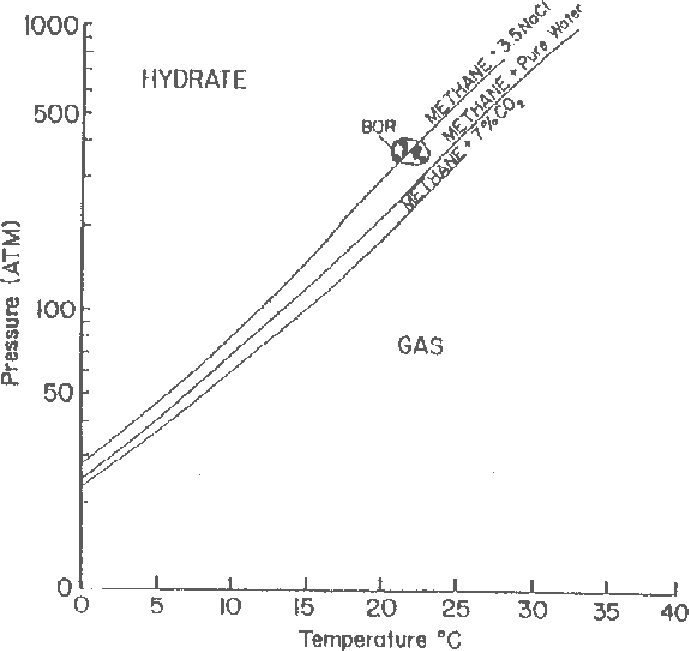




Next: BLAKE OUTER RIDGE SEISMIC
Up: Ecker & Lumley: AVO
Previous: Introduction
A methane hydrate is an ice-like, crystalline lattice of water molecules in
which gas molecules are trapped physically without the aid of direct chemical
bonds. It forms only under certain pressure and temperature conditions
(Figure ![[*]](http://sepwww.stanford.edu/latex2html/cross_ref_motif.gif) ) which restrict the BSRs to two regions: polar and deep
oceanic. In polar regions, the BSRs are normally associated with permafrost
both onshore in continental sediment and offshore in sediment of the continental
shelves. In deep oceanic regions, BSRs are found in outer continental margins
in sediment of slopes and rises where cold bottom water is present.
) which restrict the BSRs to two regions: polar and deep
oceanic. In polar regions, the BSRs are normally associated with permafrost
both onshore in continental sediment and offshore in sediment of the continental
shelves. In deep oceanic regions, BSRs are found in outer continental margins
in sediment of slopes and rises where cold bottom water is present.
hydrate
Figure 1 Pressure-Temperature relation
for hydrate stability at different compositions. BOR indicates the conditions
at the Blake Outer Ridge.

Two models have been proposed to account for gas hydrate formation and the
development of BSRs. In the first, methane is assumed to be generated
locally from organic material at the depth of the hydrate. As the zone of
methane hydrate thickens and deepens, its base eventually subsides into a
temperature region where the hydrate is unstable. In this region free gas can
occur Kvenvolden and Barnard (1983a). As a consequence, the BSR is caused
by the impedance contrast at the base of the hydrate layer and top of the
gas layer. The second model assumes that the methane
hydrates are formed through the removal of methane from rising pore fluids
being expelled upwards from deeper in the sediment section Hyndman and Davis (1992). Most of the methane
is generated at depths below the hydrate stability zone but not
at depths sufficient for the formation of thermogenic methane. Therefore, the
methane hydrates should be concentrated at the base of the stability zone and
free gas does not have to be present below the BSR. In this case
the BSR is the consequence of the impedance contrast between overlying
sediments containing substantial amounts of high-velocity hydrate and
underlying normal velocity brine sediments.
The approximate AVO amplitude responses of these BSR reflection models, based on
linearized Zoeppritz reflection coefficients, are shown in Figure ![[*]](http://sepwww.stanford.edu/latex2html/cross_ref_motif.gif) .
.
avo
Figure 2 Expected BSR AVO curves for
hydrate overlaying brine sediment, and hydrate overlaying free methane gas.

A transition from overlying sediment containing methane hydrate to sediment
containing free gas, having a low Poisson's ratio, gives a large
decrease in Poisson's ratio and thus reflection amplitudes increase
rapidly with increasing angle. On the other hand, sediment containing methane
hydrate overlying brine sediment does not much change the amplitude with
increasing offset.
A comparison between this expected behavior with the one observed in this study
should give a first order insight into the possible origin of the BSR in the
data.





Next: BLAKE OUTER RIDGE SEISMIC
Up: Ecker & Lumley: AVO
Previous: Introduction
Stanford Exploration Project
11/16/1997
![[*]](http://sepwww.stanford.edu/latex2html/cross_ref_motif.gif) ) which restrict the BSRs to two regions: polar and deep
oceanic. In polar regions, the BSRs are normally associated with permafrost
both onshore in continental sediment and offshore in sediment of the continental
shelves. In deep oceanic regions, BSRs are found in outer continental margins
in sediment of slopes and rises where cold bottom water is present.
) which restrict the BSRs to two regions: polar and deep
oceanic. In polar regions, the BSRs are normally associated with permafrost
both onshore in continental sediment and offshore in sediment of the continental
shelves. In deep oceanic regions, BSRs are found in outer continental margins
in sediment of slopes and rises where cold bottom water is present.

